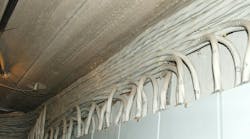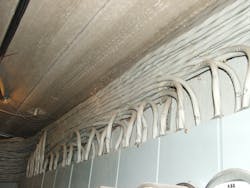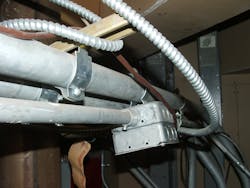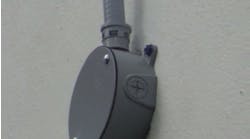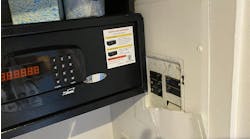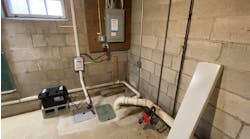All references are based on the 2023 edition of the NEC.
Not a Bundle of Joy!
The only supports for most of these cables are the other cables. There are a few pieces of strut secured to the plywood behind this massive bundle of cables, but only the first layer of cables is secured to that strut with cable ties — and that first layer of cables is used to support every additional layer of cables. Section 300.11(D) prohibits cable wiring methods from being used as a means of support for other cables, raceways, or other equipment. I cannot be sure of the exact number of cables in this gigantic bundle, but it is approximately 60 apartment feeder cables. That amount of cables makes me wonder if the installers accounted for the number of current-carrying conductors when determining the cable ampacity. Since these cables are installed without maintaining any spacing between them, Sec. 310.15(C)(1) requires their ampacity to be reduced in accordance with Table 310.15(C)(1). Since there are more than 41 current-carrying conductors in this bundle, an adjustment of 35% of the ampacity value in Table 310.16 must be used. The writing on the cable jackets indicated that these cables contain 4 AWG aluminum XHHW conductors. Table 310.16 has 4 AWG aluminum XHHW being rated for 75A. Normally, that might be perfectly fine for a 60A feeder for an apartment. But, when you apply the 35% adjustment factor, it brings the ampacity down to only 26.25 amps.
Sloppy Support Methods
The first two 1½ in. EMT raceways installed here are supported on a bracket made of strut. This is fine. However, whoever installed the ¾ in. EMT and those boxes unfortunately decided to use one of the original 1½ in. EMTs to support the ¾ in. EMT and the box assembly. Section 358.12(2) prohibits using EMT to support luminaires or other equipment except conduit bodies no larger than the trade size of the EMT. Section 300.11(C) also restricts using raceways as a means of support for other raceways, cables, and equipment. Sections 314.23(A)-(H) provide plenty of options for supporting and securing boxes. However, if you read through all those permitted options, you will not see permission to use EMT as a means of support for a box. I’m not sure if those are metal-clad (MC) or armored cable (AC), but in either case, they don’t appear to be supported and secured in a Code-compliant manner either. Section 320.30 provides the securing and supporting requirements for Type AC cables. Section 330.30 provides the securing and supporting requirements for Type MC cables.
